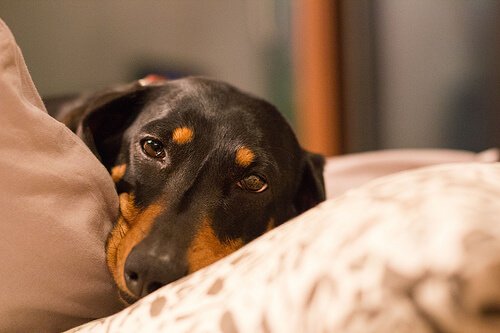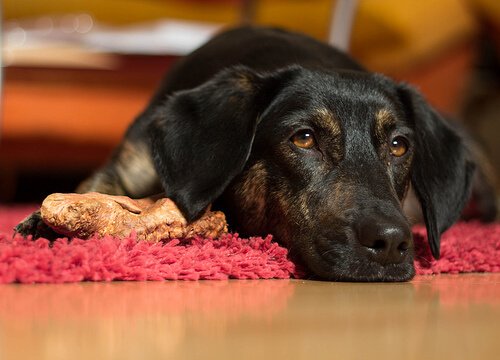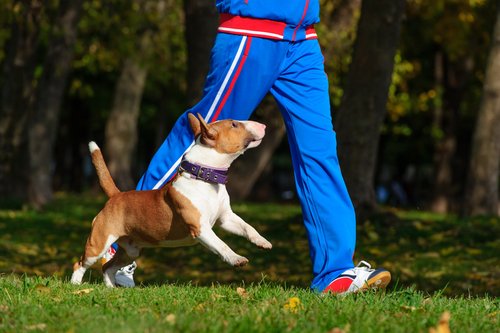How to Prevent and Treat Dog Bloat
4 minutes

Digestive problems are becoming more common in pets, especially in large and medium-sized dog breeds. Therefore, you need to know what to do when your dog is bloated.
It’s true that love and dedication are essential to a pet’s health. However, they are not the only aspects to keep a good eye on regarding their upbringing. An owner must make sure his dogs health is well-balanced. Regular visits to your veterinarian, making sure your dog gets his proper vaccines and anti-parasitic treatments are all necessary.
What is dog bloat?
Do bloat is also known by its scientific name, gastric dilatation volvulus (GDV), or gastric torsion. It is characterized by an overstretched stomach that may twist over itself. In other words, the dilated stomach can rotate on its own axis.

Canine bloating can damage other organs such as the spleen, liver, and pancreas. It also blocks the blood circulation and causes a deficiency of vital nutrients for the body, which causes the do to go into shock.
Dilation is the result of fermentation and production of excessive gases during digestion. In turn, excessive fermentation is often the result of an unbalanced diet. It can take place when a dog eats a lot of food at once, without chewing it properly. Gastric torsion mostly affects medium, large, and giant-sized dogs. It’s uncommon in smaller canine breeds.
What are the symptoms of dog bloat?
If you want to diagnose this problem beforehand, you must be knowledgeable with the symptoms.
These are the most frequent symptoms of stomach torsion:
- Swollen belly.
- Abdominal pains.
- Nausea and vomiting.
- Accelerated respiration and heart rate.
- Mucus and pale gums.
- Excessive nervousness and/or anxiety.
- Fatigue and loss of appetite.
The first symptom is the most obvious. Stomach dilation immediately produces abdominal cavity swelling. Taking your pet to the vet immediately after recognizing this symptom can save his life.
The pain is so excruciating that the dog will cry if you simply touch his abdomen. In the beginning, the animal will be constantly annoyed by his upset stomach. Later on, he’ll remain lying down and lose his appetite.
How to prevent dog bloat
It’s important to take proper precautions so a dog does not develop this syndrome. The 4 tips to prevent gastric torsion are:
Choose appropriate food
A proper diet balances both quantity and quality. Don’t believe all advertisements you see. The most expensive or trendiest food is not always the best.
It’s important to understand that there aren’t exactly better or worse foods. However, there are foods that suit your pet best. Each dog has different dietary needs according to his breed, demeanor, age and lifestyle.
Therefore, food choices must be directed by a veterinarian. The owner should follow the vet’s guidelines and avoid adding human food into the dog’s diet. This can cause serious digestive problems.
Adjust your dog’s daily portion of food
It’s common for owners to arbitrarily increase the amount of food when they think that the dog is not satisfied or is too thin. This is not a good idea. You should talk to a veterinarian, if the dog does not gain muscle mass, has no energy or looks hungry. These may be symptoms of a certain disease or parasitic infection.
It’s possible that their food doesn’t satisfy them completely, and it may be necessary to adjust their daily portion size. No matter what, professional help is recommended. As a general rule, you should divide the daily amount into 3 small portions. Never give your dog all of his food in one serving.
Water and food
You should remove the water dish while the dog is eating. You could put it back 30 minutes after he finishes eating.
Don’t exercise right after eating
You should wait at least 30 minutes before taking a walk or exercising a dog that has just finished eating.

How do you treat dog bloat?
If it has been diagnosed early on, dog bloat can be resolved by suction. The veterinarian inserts a tube into the animal’s stomach through the mouth and removes the excess gas. However, if torsion has already occurred, the tube cannot be inserted. The treatment will then need to be done by surgical intervention.
Many veterinarians will recommend performing the surgical procedure as a preventive measure if the animal has already shown signs of gastric torsion.
Main image source: Emily Orpin
